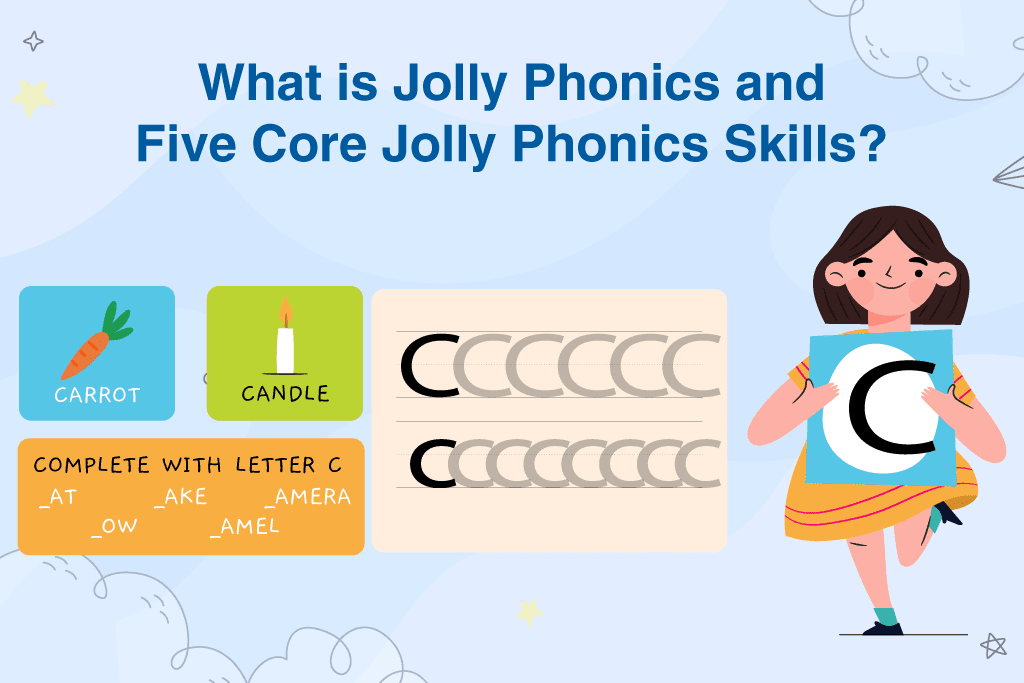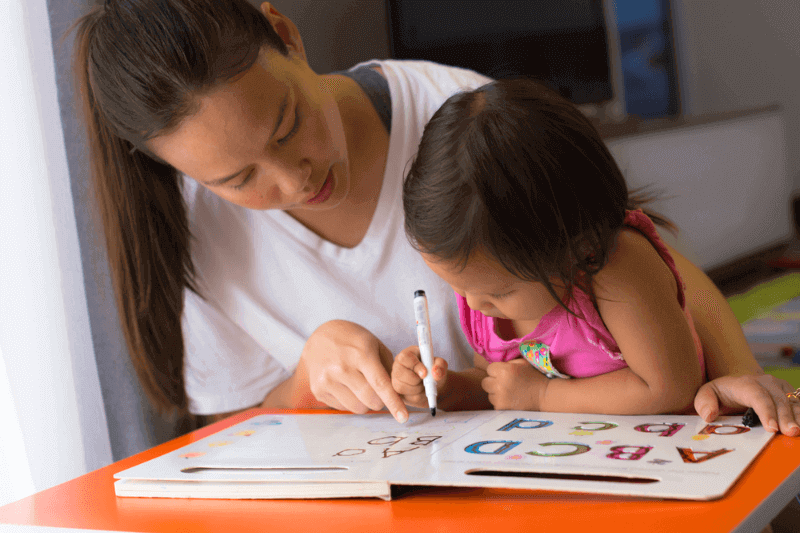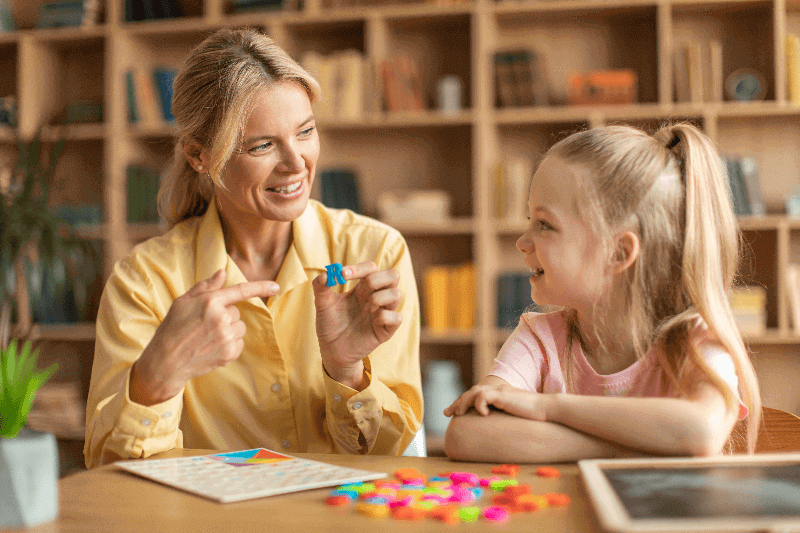What is Jolly Phonics and Five Core Jolly Phonics Skills?
A strong foundation in English literacy is a crucial requirement to survive and succeed both in educational and social lives. Research shows that Jolly Phonics helps children develop early reading and literacy skills. This blog will explore how as a Jolly Phonics trainer in India, you can implement the 5 skills of teaching phonics and develop children’s English literacy.
Unlock your child’s potential with Jolly Phonics! Discover the five core skills and how they can help your child succeed in phonics learning.
A] What is Jolly Phonics?
Sue Lloyd developed Jolly Phonics, a phonics-based program based on synesthetic phonics. Initially, she was employed as a teacher at Woods Loke Primary School, Lowestoft, England, and Sara Wernham – publisher of Jolly Learning, the UK, owned by Christopher Jolly.
Jolly Phonics is multi-sensory, child-centred, and fun, so it’s great for kids of all abilities. With Jolly Phonics, literacy is taught using synthetic phonics in a child-friendly way. Using multi-sensory methods to motivate children is scientifically supported by evidence, and it’s widely used worldwide.
Jolly Phonics is a program that teaches and practices the English alphabetic code. The phonics curriculum cannot serve as a substitute for English lessons.
There are included actions for every 42-letter sound. The Letter Sound Order chart below illustrates how the letter sounds fall into seven groups.
B] Five Core Jolly Phonics Skills
Jolly Phonics is based on five core skills:
- Learning the Letter Sounds
- Learning Letter Formation
- Blending
- Identifying Sounds in Words
- Tricky Words
Read: 10 Tips for teaching consonant blends
We will explore more of the examples and explanations for all 5 basic skills in jolly phonics.
1. Learning the Letter Sounds
The first and foremost of the 5 basic skills of jolly phonics is learning the letter sounds. A total of 42 sounds of English are taught – one sound every day, in the Jolly Phonics recommended order.
| s, a, t, i, p, n
ck, e, h, r, m, d g, o, u, l, f, b ai, j, oa, ie, ee, or z, w, ng, v, oo, oo y, x, ch, sh, th qu, ou, oi, ue, er, ar |
For kids to become familiar with letters, a multisensory approach is used. Each sound is presented through a storyline, an action, and a Sound Sheet. This will enable the children to be more likely to recognize and remember what the sound is by doing it by associating it with something.
For example, they can rub their stomachs when they say “mmmm” for the /m/ sound in the word.
The ‘r’ sound is often taught by motion with two hands spread and moving like an aeroplane ‘RRRRRRR……’.
The ‘h’ sound can be taught to the children as if one is tired and making a ‘ha……’ noise.
Each child is provided with a unique Sound Book. The sound book consists of the letter sound for every single day. The book can be kept and taken home. Parents have to help their children learn the sounds.
Either read the Sound Book or cut up the letters to accomplish this. To incorporate learning quickly, learning the letter sounds fluent is essential.
The flashcards of every day should be shown to the children as they act as visual aid. Two letters can often represent some sounds, known as digraphs, and children should be able to recognize digraphs within words, like the ‘ng’ in strong.’
Digraphs like ‘oo’ and ‘th’ can have two sounds: e.g., book and moon, thin and that. Jolly Phonics has these written in two sizes at first to make it easier for the children to understand the difference between the two sounds.
2. Learning Letter Formation
Jolly Phonics teaches children how to form each letter correctly to learn how it sounds. Initially, the teacher is supposed to have the children form the letters simultaneously in the air. After the initial 12 weeks, most children can correctly create letters by feeling and writing each.
However, it is also essential for children to learn how to hold their pencils properly and to use the tripod grip. Jolly Phonics employs using the Sassoon Infant text face with joining tails, making learning cursive (joined-up) writing much easier for them.
3. Blending
The program lets the children learn the sounds and ways to mix them to form words. This begins on the first day of learning. It is equally important that the children hear the sound when their teacher is speaking. For example, “Listen carefully, what word am I saying… d-o-g?” The children are likely to hear “dog.” A few more words are possible, like ‘su-n,’ ‘ boy,’ or ‘mouse.’
After the children understand to recognize these sounds and hear them verbally, they will be better able to create their own words. To read, children should be able to mix letters and sounds fluent, and this skill is essential from the beginning and can be used as a starting point to figure out unfamiliar words. Also, children can recognize and blend words such as “fl-a-g” and “sh-o-p.”.
Once the children have learned the letter sounds and can read some simple regular words, they can move on to the ‘Word Boxes home’ for practice.
The Word Boxes package consists of simple words from the first set of letter sounds. Children who can blend all the sounds quickly often become fluent readers.
In the beginning, one way of spelling vowels is taught. The children must be able to mix these spellings in words before the teacher teaches the alternative spellings.
Once the children have completed the Word Boxes and discovered some uncommon keywords, they can receive storybooks.
It is essential to inform parents that the child cannot bring home a storybook until they have mastered the art of blending. Parents should therefore encourage their children to talk about the books they have read.
4. Identifying Sounds in Words
Children should be able to listen to individual sounds in words. This is particularly important for writing. The children are asked to listen to the sounds closely and then identify a particular sound in words. The teacher can consider asking – “Are there any ’s’ sound in the word “sun,” “mouse,” or “dog ‘?”;
It is essential to encourage children to use the sounds they hear. The teacher should write the letters on the chalkboard when the children speak. The children can then look at the word and make the sounds, which will help blend the sounds while reading it.
This will also provide a better understanding of the process of reading and writing. Such skills can be developed by practising some examples every day.
The child can move to write independently once they can hear and write the sounds. While they cannot spell them correctly at first, their work can still be read.
By the end of their first year, the children can independently write simple stories and news. They will be able to write precisely what they want, as they will not have to stick to the words they know.
Learning to spell correctly often takes time, as well as reading books and learning the alternate sounds of the vowel.
5. Tricky Words
After the first month, most children are familiar with 18 letter sounds, as they have been learning to blend the regular words as a group activity. They can now learn tricky words, and tricky words are often words that cannot be merged.
These words can be introduced to the children slowly by employing the Jolly Phonics Tricky Word Cards. The children can look at the ‘tricky’ part of each word. The teacher should be able to teach 2-3 times per week to help the children to be at the top of spelling and reading.
The following are three spelling techniques you can use while teaching tricky words:
1) Identify the irregularity and say the letter names
2) Saying it as a sound
3) Using mnemonics to spell the word
Unlock your child’s potential with Jolly Phonics! Discover the five core skills and how they can help your child succeed in phonics learning.
Conclusion
English literacy skills must be introduced earlier to children as English is the prime position in communication today.
For the best result, the teacher should carefully plan the course considering the children’s needs and abilities. Jolly Phonics has proven itself as an extensively researched and proven effective method for children.
The 5 skills of teaching jolly phonics that utilise various techniques are powerful ways to develop and enhance children’s English literacy. A synthetic phonics approach is aimed at – teaching letter sounds in isolation and how to blend them to read a word. This approach is considered the foundation for Jolly Phonics teaching. If you are interested in how to help children overcome common problems with reading, check out this blog!
Contact us for information on Phonic classes for children.



